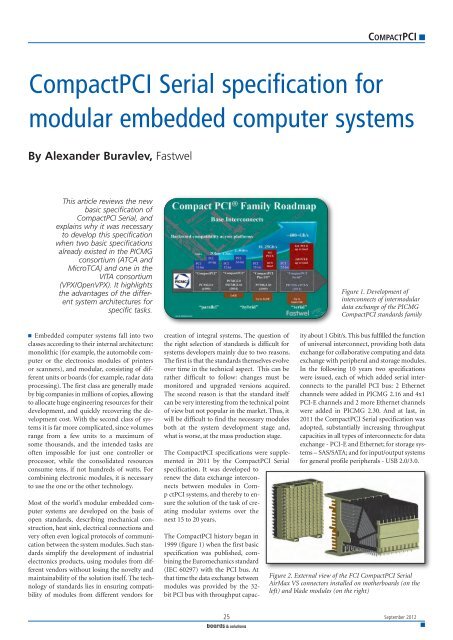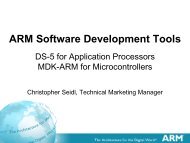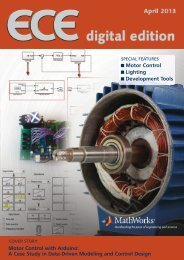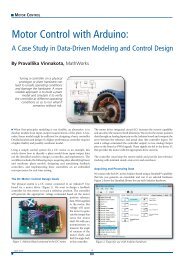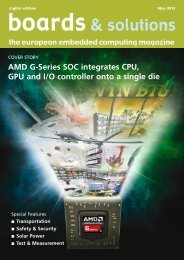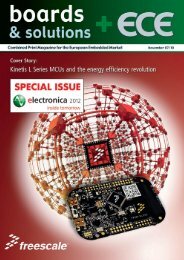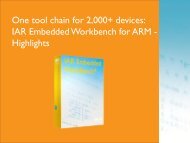CompactPCI Serial specification for modular embedded computer ...
CompactPCI Serial specification for modular embedded computer ...
CompactPCI Serial specification for modular embedded computer ...
Create successful ePaper yourself
Turn your PDF publications into a flip-book with our unique Google optimized e-Paper software.
<strong>CompactPCI</strong> <strong>Serial</strong> <strong>specification</strong> <strong>for</strong><br />
n Embedded <strong>computer</strong> systems fall into two<br />
classes according to their internal architecture:<br />
monolithic (<strong>for</strong> example, the automobile <strong>computer</strong><br />
or the electronics modules of printers<br />
or scanners), and <strong>modular</strong>, consisting of different<br />
units or boards (<strong>for</strong> example, radar data<br />
processing). The first class are generally made<br />
by big companies in millions of copies, allowing<br />
to allocate huge engineering resources <strong>for</strong> their<br />
development, and quickly recovering the development<br />
cost. With the second class of systems<br />
it is far more complicated, since volumes<br />
range from a few units to a maximum of<br />
some thousands, and the intended tasks are<br />
often impossible <strong>for</strong> just one controller or<br />
processor, while the consolidated resources<br />
consume tens, if not hundreds of watts. For<br />
combining electronic modules, it is necessary<br />
to use the one or the other technology.<br />
Most of the world’s <strong>modular</strong> <strong>embedded</strong> <strong>computer</strong><br />
systems are developed on the basis of<br />
open standards, describing mechanical construction,<br />
heat sink, electrical connections and<br />
very often even logical protocols of communication<br />
between the system modules. Such standards<br />
simplify the development of industrial<br />
electronics products, using modules from different<br />
vendors without losing the novelty and<br />
maintainability of the solution itself. The technology<br />
of standards lies in ensuring compatibility<br />
of modules from different vendors <strong>for</strong><br />
creation of integral systems. The question of<br />
the right selection of standards is difficult <strong>for</strong><br />
systems developers mainly due to two reasons.<br />
The first is that the standards themselves evolve<br />
over time in the technical aspect. This can be<br />
rather difficult to follow: changes must be<br />
monitored and upgraded versions acquired.<br />
The second reason is that the standard itself<br />
can be very interesting from the technical point<br />
of view but not popular in the market. Thus, it<br />
will be difficult to find the necessary modules<br />
both at the system development stage and,<br />
what is worse, at the mass production stage.<br />
The <strong>CompactPCI</strong> <strong>specification</strong>s were supplemented<br />
in 2011 by the <strong>CompactPCI</strong> <strong>Serial</strong><br />
<strong>specification</strong>. It was developed to<br />
renew the data exchange interconnects<br />
between modules in Comp<br />
ctPCI systems, and thereby to ensure<br />
the solution of the task of creating<br />
<strong>modular</strong> systems over the<br />
next 15 to 20 years.<br />
The <strong>CompactPCI</strong> history began in<br />
1999 (figure 1) when the first basic<br />
<strong>specification</strong> was published, combining<br />
the Euromechanics standard<br />
(IEC 60297) with the PCI bus. At<br />
that time the data exchange between<br />
modules was provided by the 32bit<br />
PCI bus with throughput capac-<br />
COMPACTPCI<br />
<strong>modular</strong> <strong>embedded</strong> <strong>computer</strong> systems<br />
By Alexander Buravlev, Fastwel<br />
This article reviews the new<br />
basic <strong>specification</strong> of<br />
<strong>CompactPCI</strong> <strong>Serial</strong>, and<br />
explains why it was necessary<br />
to develop this <strong>specification</strong><br />
when two basic <strong>specification</strong>s<br />
already existed in the PICMG<br />
consortium (ATCA and<br />
MicroTCA) and one in the<br />
VITA consortium<br />
(VPX/OpenVPX). It highlights<br />
the advantages of the different<br />
system architectures <strong>for</strong><br />
specific tasks.<br />
Figure 1. Development of<br />
interconnects of inter<strong>modular</strong><br />
data exchange of the PICMG<br />
<strong>CompactPCI</strong> standards family<br />
ity about 1 Gbit/s. This bus fulfilled the function<br />
of universal interconnect, providing both data<br />
exchange <strong>for</strong> collaborative computing and data<br />
exchange with peripheral and storage modules.<br />
In the following 10 years two <strong>specification</strong>s<br />
were issued, each of which added serial interconnects<br />
to the parallel PCI bus: 2 Ethernet<br />
channels were added in PICMG 2.16 and 4x1<br />
PCI-E channels and 2 more Ethernet channels<br />
were added in PICMG 2.30. And at last, in<br />
2011 the <strong>CompactPCI</strong> <strong>Serial</strong> <strong>specification</strong> was<br />
adopted, substantially increasing throughput<br />
capacities in all types of interconnects: <strong>for</strong> data<br />
exchange - PCI-E and Ethernet; <strong>for</strong> storage systems<br />
– SAS/SATA; and <strong>for</strong> input/output systems<br />
<strong>for</strong> general profile peripherals - USB 2.0/3.0.<br />
Figure 2. External view of the FCI <strong>CompactPCI</strong> <strong>Serial</strong><br />
AirMax VS connectors installed on motherboards (on the<br />
left) and blade modules (on the right)<br />
25 September 2012
COMPACTPCI<br />
<strong>CompactPCI</strong> <strong>Serial</strong> at first looks to be a logical<br />
continuation of the tendency of step-by-step<br />
transition from parallel buses to serial interconnects<br />
of point-to-point type, but if you<br />
look at it more deeply and familiarize yourself<br />
with details, you will see that the <strong>CompactPCI</strong><br />
<strong>Serial</strong> <strong>specification</strong> represents the new basic<br />
<strong>specification</strong> of the standard family, and this<br />
is very important <strong>for</strong> the industry and developers<br />
of <strong>embedded</strong> systems.<br />
<strong>CompactPCI</strong> <strong>Serial</strong> has five key innovations:<br />
new connectors, high speed interconnects, new<br />
layout of connectors on 6U boards, a new<br />
power supply scheme and conductive cooling<br />
technology. Connectors: <strong>CompactPCI</strong> <strong>Serial</strong><br />
uses new high-density connectors <strong>for</strong> data<br />
transfer both on the side of blade modules<br />
and on the side of motherboards (figure 2).<br />
Testing of connectors, <strong>for</strong> example, FCI AirMax<br />
connectors, showed high quality of signals<br />
transmission up to 12.5 GHz.<br />
Connectors structure allows installation from<br />
different sides of the board, allowing thereby<br />
to apply the mezzanine concept of blade modules<br />
creation with connection of mezzanines<br />
directly to motherboards. Interconnects: <strong>CompactPCI</strong><br />
<strong>Serial</strong> outlines expressly the four types<br />
of interconnects pins (pinout) designation<br />
and one I2C check bus on the system controllers<br />
and peripheral connectors: 8 PCI-E<br />
channels, two of which are 8 and the remaining<br />
six are 4; eight Ethernet Base-T channels;<br />
eight SAS/SATA channels; eight USB 2.0 or<br />
USB 3.0 channels; I2C bus <strong>for</strong> control and<br />
monitoring of system service parameters. At<br />
the physical level each channel consists of two<br />
differential pairs, providing data transfer from<br />
source to receiver and reverse. As all Compact-<br />
PCI <strong>Serial</strong> interconnects are serial, the <strong>specification</strong><br />
describes their topology, namely: PCI-<br />
E, SATA and USB have star topology with the<br />
September 2012 26<br />
system controller (Syst) as a host, while Ethernet<br />
has a full mesh topology or, in other words,<br />
“each-to-each” topology (figure 3). It is important<br />
to note that the <strong>CompactPCI</strong> <strong>Serial</strong> standard<br />
does not impose restrictions on the configuration<br />
of motherboards, leaving this decision<br />
up to the customer and motherboard<br />
manufacturer. Respectively, some systems can<br />
be designed <strong>for</strong> connection of only one application<br />
or peripheral (Per.) module, the others<br />
- <strong>for</strong> connection of up to 24 application modules.<br />
<strong>CompactPCI</strong> <strong>Serial</strong> <strong>for</strong> 6U modules describes<br />
an additional connector on the system<br />
controller module, providing two additional<br />
Ethernet channels which can be used <strong>for</strong> ensuring<br />
compatibility with PICMG 2.16, and<br />
an additional power supply.<br />
The mechanical structure underwent few<br />
changes but resulted in significant consequences<br />
<strong>for</strong> the 6U systems. Thus, all connectors <strong>for</strong><br />
connection to the motherboard are now located<br />
in the upper half of the 6U plate, while the<br />
lower half remains free and can be used <strong>for</strong> installation<br />
of connectors according to customer<br />
<strong>specification</strong>s and/or <strong>for</strong> direct connection to<br />
a rear I/O module (figure 4). If the organization<br />
of the 6U system does not require support of<br />
PICMG 2.16 and additional power supply, 3U<br />
motherboards can be used in such systems.<br />
Figure 5 illustrates different options <strong>for</strong> the<br />
implementation of <strong>CompactPCI</strong> <strong>Serial</strong> systems<br />
(a, b, c) and hybrid systems (d) with monolithic<br />
(a, c) and composite (b, d) motherboards. Advantages<br />
consist in the reduction of prices <strong>for</strong><br />
motherboards - they now became smaller and<br />
simpler to manufacture, as well as the possibility<br />
of supporting inherited (i.e. inherited from<br />
previous <strong>specification</strong>s) interconnects (Ethernet<br />
and PCI), and the creation of hybrid systems.<br />
In addition to the improvements already mentioned,<br />
there is one special mechanical element<br />
Figure 3. Inter<strong>modular</strong> interconnects topologies in the <strong>CompactPCI</strong> <strong>Serial</strong> <strong>specification</strong>:<br />
a) PCI-E, SATA and USB; b) Ethernet
COMPACTPCI<br />
Figure 4. Examples of connection of front and rear I/O cards to <strong>CompactPCI</strong> <strong>Serial</strong> motherboards<br />
<strong>for</strong> the 6U (a) and 3U (b) systems<br />
in 3U modules and two mechanical elements<br />
in 6U modules, directing and centering the<br />
boards when connecting to the motherboard<br />
to simplify the processes of systems assembling<br />
and modules replacement <strong>for</strong> repair.<br />
New connectors also allowed improving the<br />
power supply system. Specifically, <strong>CompactPCI</strong><br />
<strong>Serial</strong> requires only one supply voltage (+12V)<br />
with maximum input power of 79.8W <strong>for</strong> each<br />
3U module and 171W <strong>for</strong> each 6U module,<br />
needed <strong>for</strong> provision of power supply to 8HP<br />
or 12HP high-productive modules, or <strong>for</strong> pro-<br />
Figure 5. Options of possible motherboard<br />
creation: a) 3U <strong>CompactPCI</strong> <strong>Serial</strong>, 8 peripheral<br />
slots; b) 6U <strong>CompactPCI</strong> <strong>Serial</strong>, 8<br />
peripheral slots, composite motherboard; c)<br />
6U <strong>CompactPCI</strong> <strong>Serial</strong>, 8 peripheral slots,<br />
monolithic motherboard; d) 6U hybrid composite<br />
motherboard with support of 2<br />
<strong>CompactPCI</strong> 2.0 peripheral blade modules<br />
and 6 <strong>CompactPCI</strong> <strong>Serial</strong> peripheral slots.<br />
vision of power supply to modules with conductive<br />
or liquid cooling. <strong>CompactPCI</strong> <strong>Serial</strong><br />
provides the system controller with the possibility<br />
to control the power supply, <strong>for</strong> example,<br />
upon occurrence of events (wake on LAN or<br />
wake on modem). There<strong>for</strong>e, the functions implemented<br />
in all modern processors and chipsets<br />
can be used <strong>for</strong> creating an <strong>embedded</strong> system.<br />
The <strong>CompactPCI</strong> <strong>Serial</strong> <strong>specification</strong> offers<br />
developers a simple option <strong>for</strong> implementation<br />
of systems with conductive cooling. This option<br />
assumes packing of the standard board in a<br />
metal holder which is inserted into the system<br />
with the 5HP step between modules. Very<br />
often the success of new technical solutions is<br />
based on the support of legacy technologies.<br />
A good example is the success of the x86<br />
processor architecture, supporting operation<br />
of the previously written program code. In<br />
the family of <strong>CompactPCI</strong> <strong>specification</strong>s, the<br />
new <strong>CompactPCI</strong> <strong>Serial</strong> <strong>specification</strong> provides<br />
systems developers with very wide possibilities<br />
of integration of inherited PICMG 2.0, 2.30<br />
and 2.16 modules within one system. The<br />
<strong>CompactPCI</strong> 2.30 (PICMG 2.30) peripheral<br />
and application modules use identical connectors<br />
and are completely compatible to <strong>CompactPCI</strong><br />
<strong>Serial</strong>.<br />
The system controllers and peripheral 3U modules<br />
can be used in 6U systems. More In<strong>for</strong>mation<br />
on the compatibility of standard modules<br />
of the <strong>CompactPCI</strong> <strong>specification</strong>s family<br />
is provided in table 1. The <strong>CompactPCI</strong> <strong>Serial</strong><br />
<strong>specification</strong> allows to implement hybrid systems<br />
in which the peripherals are based both<br />
on serial interconnects and on the inherited<br />
32 or 64-bit PCI buses. In the 3U <strong>for</strong>mat the<br />
hybrid system can be implemented, <strong>for</strong> example,<br />
by means of the PCI-E/PCI bridge module<br />
connected by a cable to the system controller,<br />
and two motherboards, locating, <strong>for</strong> example,<br />
the PCI segment on the left, and the Compact-<br />
PCI <strong>Serial</strong> segment on the right. Such an<br />
option is implemented by the MEN company.<br />
In the option offered by Fastwel, the bridge is<br />
implemented on the mezzanine on the left <strong>for</strong><br />
27 September 2012
COMPACTPCI<br />
the CPC510 system controller, which allows<br />
installing it in the PICMG 2.30 system controller<br />
slot and supporting both of the ompactPCI<br />
and PICMG 2.30 peripherals. The<br />
implementation of compatibility with inherited<br />
modules on the basis of PCI bus in the 6U <strong>for</strong>mat<br />
is already described. Compatibility with<br />
PICMG 2.16 is supported in the 6U <strong>for</strong>mat by<br />
an additional connector with two Ethernet<br />
channels.<br />
The increase in input power up to 79.8 W (<strong>for</strong><br />
3U) and 171 W (<strong>for</strong> 6U) <strong>for</strong> the <strong>CompactPCI</strong><br />
<strong>Serial</strong> system controllers allows installing practically<br />
any processors of PowerPC or x86 architecture.<br />
This way, using the advantages of<br />
mechanical structure, on the double width<br />
modules one can install not only soldered<br />
processors from the CPU suppliers mobile<br />
segment, but also server socket processors and<br />
vertically installed DIMM or SO-DIMM. We<br />
recall that the <strong>CompactPCI</strong> <strong>specification</strong> defined<br />
a power input of only 50W <strong>for</strong> both 3U<br />
and 6U modules, requiring application of proprietary<br />
methods <strong>for</strong> installation of server<br />
processors. The in<strong>for</strong>med reader may ask why<br />
it was necessary to develop a new <strong>specification</strong><br />
based on serial interconnects, if two basic <strong>specification</strong>s<br />
have already existed in the PICMG<br />
consortium (ATCA and MicroTCA) and one<br />
in the VITA consortium (VPX/OpenVPX).<br />
This is a good question, and the answer is very<br />
important from the point of view of understanding<br />
the advantages of the different system<br />
architectures <strong>for</strong> specific tasks. Let’s look at<br />
this in more detail.<br />
First of all, let’s compare such basic parameters<br />
as board areas, the possibilities of routing various<br />
interfaces <strong>for</strong> data input-output, and installing<br />
different components on board, as<br />
well as heat budgets. The overall dimensions<br />
and heat budgets of <strong>CompactPCI</strong> (CPCI) and<br />
VME modules are identical, there<strong>for</strong>e they<br />
can be reviewed jointly. The AMC blade modules<br />
used in the MicroTCA standard may have<br />
3HP, 4HP or 6HP width and two board sizes –<br />
single or double. If we compare the areas of<br />
the CPCI/VME boards with the size of the<br />
AMC and ATCA boards, we arrive at two obvious<br />
conclusions as regards locating electronic<br />
components, radiators and air heat sinks. 1)<br />
The ATCA modules are non-comparable and<br />
there<strong>for</strong>e do not compete in any way with<br />
CPCI/VME and MicroTCA (figure 6a). 2) The<br />
CPCI/VME modules in 3U <strong>for</strong>mat have comparable<br />
characteristics with the single-size<br />
AMC blade modules <strong>for</strong> the MicroTCA systems,<br />
while the CPCI/VME modules in 6U <strong>for</strong>mat<br />
show substantial advantages (plus 60 %) over<br />
MicroTCA.<br />
It is necessary to note that the CPCI/VME<br />
manufacturers widely use the possibility of increasing<br />
the board width up to 8HP, and even<br />
up to 12HP, by installing additional boards<br />
and locating the functions required thereon,<br />
while the AMC functional modules manufacturers<br />
cannot go over the maximum size of<br />
6HP, as this size is defined by the restriction<br />
on mezzanine thickness in (AMC is a mezzanine<br />
<strong>for</strong> ATCA). The conclusion is thus: the<br />
CPCI/ VME <strong>specification</strong>s allow installing a<br />
bigger number of components, and components<br />
of a bigger size, on the blade modules,<br />
as well as tolerating heavier heat loads with air<br />
cooling, than the AMC modules in the MicroTCA<br />
systems. If we look at the areas of the<br />
front panels which determine the possibilities<br />
<strong>for</strong> installing connectors and the input/output<br />
possibilities <strong>for</strong> the different interfaces, the advantage<br />
of the CPCI/VME modules becomes<br />
obvious (figure 6b).<br />
To be fair, it is necessary to note that the new<br />
MicroTCA.4 standard adopted in 2011 supports<br />
the possibility of directly connecting
COMPACTPCI<br />
Figure 6. Comparison of CPCI/VME, MicroTCA and ATCA technologies: a) according to useful<br />
areas on boards <strong>for</strong> location of electronic components and heat sink and air cooling capabilities;<br />
b) according to useful areas of panels <strong>for</strong> location of I/O connectors.<br />
front modules to rear modules of the same<br />
size, thereby doubling the area <strong>for</strong> components<br />
installation, and increasing the output capacity<br />
by roughly 50%. Thus, in regard to board area<br />
extension and components installation thereon,<br />
it can be said that the <strong>CompactPCI</strong> and VME<br />
<strong>specification</strong>s benefit compared with MicroT-<br />
CA, while in regard to the input-output capabilities,<br />
they have substantial advantage over<br />
MicroTCA.<br />
The VPX/OpenVPX family standards were developed<br />
by a group of contracting companies<br />
<strong>for</strong> the United States Department of Defense,<br />
with the target task of updating the VME<br />
<strong>specification</strong> and inventing a new technology<br />
<strong>for</strong> creating <strong>modular</strong> <strong>embedded</strong> systems <strong>for</strong><br />
their customer. Originally the VPX standard<br />
(ANSI/VITA 46.0-2007 VPX: Base <strong>specification</strong>)<br />
was based on the use of new plated<br />
MultiGig RT2 connectors from Tyco Electronics<br />
with throughput capacity of 6.25 GHz; this allowed<br />
using 64 differential pairs <strong>for</strong> ensuring<br />
intermodule communication in the system on<br />
the basis of 3U boards and 192 pairs <strong>for</strong> 6U.<br />
Recently, a new connector with a throughput<br />
capacity of 10 GHz comparable to <strong>CompactPCI</strong><br />
<strong>Serial</strong> has been standardized <strong>for</strong> the VPX/Open-<br />
VPX systems (ANSI/VITA 60.0-2012 VPX: Alternative<br />
connector <strong>for</strong> VPX). Accordingly, the<br />
VPX modules and systems manufacturers have<br />
no barrier to increasing the speed; only the<br />
timely and organized migration to use the<br />
new connector is required as the VITA 46<br />
modules and motherboards are incompatible<br />
with VITA 60.<br />
The next and, probably, the most important<br />
difference is the approach to description of<br />
pinouts in the <strong>CompactPCI</strong> <strong>Serial</strong> and<br />
VPX/OpenVPX standards. Namely, the <strong>CompactPCI</strong><br />
<strong>Serial</strong> standard expressly defines at<br />
which connector pin the signal should be present.<br />
The OpenVPX standard gives this determination<br />
to the so-named profiles (pins designation<br />
and interconnection topology). These<br />
are subdivided into the modules, slots and<br />
motherboard profiles, with the number of<br />
profiles of each type described in the OpenVPX<br />
<strong>specification</strong> <strong>for</strong> 3U and 6U modules designated<br />
in tens and sometimes in hundreds<br />
(table 2). Besides, the list of standardized interconnects<br />
is wider than in <strong>CompactPCI</strong><br />
<strong>Serial</strong>, and the topologies of their connections<br />
include a double star, a ring, a mesh and<br />
others. In fact, OpenVPX appears as the reference<br />
manual (and the OpenVPX developers<br />
do not hide it even in the standard name:<br />
ANSI/VITA 65.0-2010 OpenVPX Architectural<br />
Framework <strong>for</strong> VPX), describing a great diversity<br />
of inter<strong>modular</strong> exchange technology implementations,<br />
while <strong>CompactPCI</strong> <strong>Serial</strong> describes<br />
specific implementations of technology.<br />
The consequences are simple and complex at<br />
the same time: inter<strong>modular</strong> compatibility is<br />
possible only within compatible profiles, which<br />
in practice means – from one manufacturer.<br />
By contrast, <strong>CompactPCI</strong> <strong>Serial</strong> allows the assembly<br />
of systems with modules produced by<br />
different companies, since the inter<strong>modular</strong><br />
compatibility is guaranteed by the <strong>specification</strong>.<br />
And logically we see that <strong>CompactPCI</strong> <strong>Serial</strong><br />
per<strong>for</strong>ms the function of facilitating creation<br />
of <strong>modular</strong> systems, so long as the modules<br />
are known to be compatible with each other.<br />
The VPX/OpenVPX <strong>specification</strong> allows very<br />
high values of input power <strong>for</strong> the module<br />
which can be used <strong>for</strong> construction of systems<br />
with liquid cooling, as well as a bigger number<br />
of differential pairs in the 6U VPX/OpenVPX<br />
systems in comparison with ompactPCI <strong>Serial</strong>,<br />
enabling higher speeds of inter<strong>modular</strong> exchange<br />
when using a number of high-productive<br />
profiles.<br />
With reference to <strong>modular</strong> plat<strong>for</strong>ms, granularity<br />
is an important parameter <strong>for</strong> developers who<br />
plan to release a line of products based on one<br />
of these technologies but with different characteristics,<br />
<strong>for</strong> example, <strong>for</strong> provision of services<br />
to a different number of subscribers or with<br />
different computational power. The granularity<br />
metrics can be different and be expressed in<br />
units of power, volume or cost, measured by a<br />
number of operations per second, etc.<br />
Systems built on the basis of the 3U Compact-<br />
PCI <strong>Serial</strong> standard have the lowest granularity,<br />
namely about 30W and $1000, and the 6U systems<br />
– about 70W and $3000. Such values of<br />
granularity are well-suited <strong>for</strong> creation of dif-<br />
29 September 2012
COMPACTPCI<br />
Table 1. Cross-compatibility of system controllers and peripherals modules <strong>for</strong> the <strong>CompactPCI</strong><br />
range standards<br />
Table 2. Comparison of the <strong>CompactPCI</strong> <strong>Serial</strong> and VPX/OpenVPX technologies<br />
ferent control and supervisory complexes, and<br />
measuring equipment. And if the 3U systems<br />
are more suitable due to their capacity <strong>for</strong> execution<br />
of customer tasks, the 6U systems have,<br />
mainly, server functionality and designation.<br />
The VPX systems given the same size and<br />
computing parameters show at least twice the<br />
cost. Accordingly, their granularity in relation<br />
to cost is higher, which may lead in some cases<br />
to going over the limits of the permissible<br />
budget when creating a line of products.<br />
The ATCA standard-based systems have the<br />
biggest granularity – about 300W and the cost<br />
of modules about $50 to $8000. Thus it makes<br />
sense to use these systems <strong>for</strong> tasks with heavy<br />
loads on the switching or computing subsystems,<br />
measured in teraflops and tens of Gbit/s.<br />
The <strong>CompactPCI</strong> <strong>Serial</strong> standard supports different<br />
back-up and hot-swap technologies.<br />
The systems developers have all possibilities<br />
open <strong>for</strong> back-up implementation. For example,<br />
peripheral modules can be duplicated or triplicated,<br />
and the replacement of an inoperable<br />
module is possible without switching the sys-<br />
tem off (hot-swap). The full intrasystem duplication<br />
can be organized by synchronization<br />
of operation of two <strong>CompactPCI</strong> <strong>Serial</strong> segments<br />
through Ethernet channels (<strong>for</strong> the 3U<br />
and 6U systems), or using intrasystem switches<br />
(only <strong>for</strong> the 6U system).<br />
It will be fair to note that complete intrasystem<br />
back-up is rarely used nowadays. More often<br />
distributed back-up is applied, allowing to increase<br />
the systems operability with power supply<br />
from different sources and use of distributed<br />
communication lines. The high level of inter<strong>modular</strong><br />
switching and support of a large<br />
number of standard interfaces, such as Ethernet,<br />
is the key to success in creating systems with<br />
distributed back-up on the basis of the <strong>CompactPCI</strong><br />
<strong>Serial</strong> <strong>specification</strong>.<br />
Originally, the first <strong>CompactPCI</strong> standard was<br />
designed <strong>for</strong> use in the public telecommunication<br />
networks core. But since the end of the<br />
1990s telecommunication networks have<br />
changed a lot, and the switching capacity provided<br />
by the <strong>CompactPCI</strong> systems (1 to 2<br />
Gbps) became insufficient. Now their place in<br />
September 2012 30<br />
the public networks core is occupied by the 10<br />
to 40 Gbps ATCA systems and the rack-mount<br />
server-based solutions. But how about <strong>CompactPCI</strong><br />
<strong>Serial</strong>?<br />
With updated high values of the internal interconnects<br />
throughput capacity, the <strong>CompactPCI</strong><br />
<strong>Serial</strong> standard can be successfully<br />
used in the IP-based systems intended <strong>for</strong> creation<br />
of network infrastructure. But new possibilities<br />
<strong>for</strong> <strong>CompactPCI</strong> <strong>Serial</strong> now more<br />
likely exist not in the cores of public telecommunication<br />
networks, but in their peripheral<br />
and boundary sections. Regardless of the customer<br />
type, whether a digital house, digital<br />
transport, digital office or subscribers, the<br />
equipment <strong>for</strong> their network access should be<br />
able to recognize different wire and wireless<br />
data transfer protocols, to aggregate and convert<br />
these flows in TCP/IP and to carry out their<br />
preprocessing. The <strong>CompactPCI</strong> <strong>Serial</strong> capacity,<br />
competitive prices and low granularity values<br />
– this is a partial list of the advantages which<br />
play a key role here.<br />
If we have a look at a private network, <strong>for</strong> example<br />
at the process equipment control network<br />
or at the vehicle control network, the<br />
<strong>CompactPCI</strong> <strong>Serial</strong> system switching capacities<br />
allow its use <strong>for</strong> resolution of tasks in the core<br />
of such a private network. Already there are<br />
some successful applications, <strong>for</strong> example, the<br />
Wi-Fi Internet system in European trains.<br />
The possibilities of the 6U <strong>CompactPCI</strong> <strong>Serial</strong><br />
standard are also interesting <strong>for</strong> creating the<br />
wire network infrastructure connected with<br />
the support of technology of the customer devices<br />
power supply via the network cable<br />
(Power over Ethernet – PoE). Such devices include<br />
IP surveillance cameras, panel <strong>computer</strong>s,<br />
controllers and other devices, consuming up<br />
to 40W. By means of the P0/J0 connector, the<br />
6U <strong>CompactPCI</strong> <strong>Serial</strong> modules can be provided<br />
with an additional power supply of –<br />
48V via the motherboard, with maximum current<br />
of 1.9A (91.2W).<br />
The CPCI/VME standards have taken a strong<br />
position in many niche markets, such as production<br />
automation, complex process equipment<br />
and programmable-controlled machines<br />
management, control and communications<br />
on transport, defense systems and many others.<br />
The new <strong>CompactPCI</strong> <strong>Serial</strong> standard allows<br />
simplifying the system creation process. The<br />
system developer has the possibility to choose<br />
between 4 types of interconnects, allowing to<br />
reduce significantly the number of bridges <strong>for</strong><br />
communication of peripherals with the system<br />
controller. Direct connection of SATA drives,<br />
including the use of chipset-integrated RAID,<br />
connection of USB cryptokeys or controllers<br />
with USB ports, CompactFlash, SD and mi-
croSD USB card readers – and this is a far<br />
from full list of the <strong>CompactPCI</strong> <strong>Serial</strong> capabilities<br />
whose implementation does not require<br />
bridge microchips and their drivers. The possibilities<br />
of releasing the PCI-E-based peripherals<br />
are extremely wide. Let’s begin the list of<br />
examples with the simplest ones – expansion<br />
modules <strong>for</strong> wire or wireless data transfer,<br />
CAN controllers and COM ports on the basis<br />
of 1 1 PCI-E. Then we continue with the lower<br />
level graphic coprocessors, controllers with<br />
„copper“ or optical interfaces – Gigabit or<br />
10Gigabit Ethernet. We close the list with<br />
graphic and network DSP or FPGA top level<br />
coprocessors on the basis of 1 8 PCI-E. It is<br />
important to note that <strong>CompactPCI</strong> <strong>Serial</strong><br />
overall dimensions allow creating these application<br />
boards in the <strong>for</strong>m of monolithic boards,<br />
or in the <strong>for</strong>m of carriers of MiniPCI Express,<br />
PCI-E, XMC, FMC cards and even of the<br />
PC/104 family.<br />
The real-time system developers and the developers<br />
of the high-productive complexes<br />
intended, <strong>for</strong> example, <strong>for</strong> processing of Fourier<br />
conversions, should see the true value of<br />
<strong>CompactPCI</strong> <strong>Serial</strong>, as the <strong>specification</strong> providing<br />
the data exchange interconnect with<br />
Product News<br />
COMPACTPCI<br />
low latency (PCI-E is supported by the system<br />
controller, there are no additional switches<br />
with their time delays) and high speeds of<br />
the inter<strong>modular</strong> exchange, thus allowing the<br />
creation of clusters combining the resources<br />
of several modules.<br />
For example, the Fastwel CPC510 module has<br />
the semi-transparent PCI-E bridge, allowing to<br />
insert it into the system controller slot and into<br />
the PCI-E peripherals slot, using it as the 4-core<br />
computing coprocessor where each core can execute<br />
up to 8 instructions of double accuracy<br />
with floating decimal point in one cycle. n


